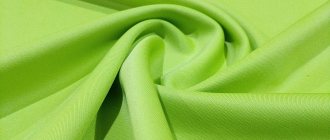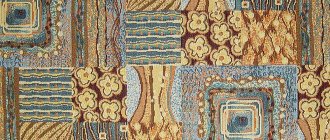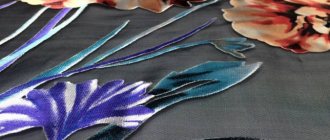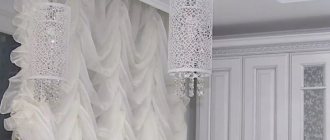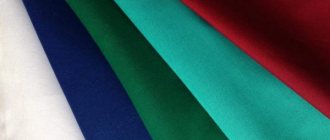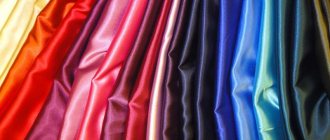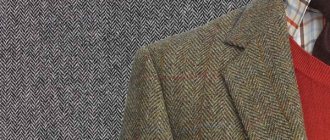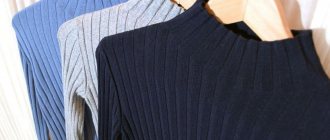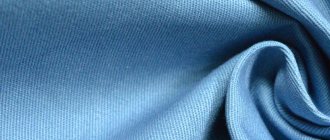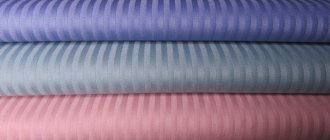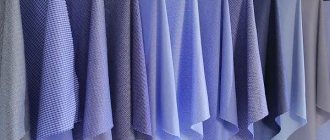Fabric production and composition
Tweed material is made from the wool of mountain sheep. At the same time, the threads undergo minimal processing: they do not twist, so they turn out thick and with fibers. On the market you can find both 100% natural tweed and fabric with the addition of other natural and artificial threads. This improves the performance properties of the material - increases strength and wear resistance.
Tweed fabric is woven using a traditional twill weave, where the warp thread wraps around two or three weft threads. The texture of the fabric is ribbed, similar to gabardine or denim. The pattern is located diagonally on the canvas.
Wool fibers are dyed mainly with natural dyes, thanks to which tweed fabric receives deep and rich tones. Of course, the use of chemical paints also occurs; they allow you to achieve a durable and bright color.
Story
Where was wool tweed fabric invented? The birthplace of the material is Scotland . Heavy, dense and rough fabric began to be produced in the 19th century on the Isle of Lewis, in a place called Harris. British weather conditions were characterized by high humidity, frequent cold and winds.
The first tweed outerwear, produced primarily for men, reliably protected against negative environmental factors.
Matter received its name completely by accident. According to the first version, the fabric was named after the Tweed River of the same name, which flows on the border of Scotland and England . Proponents of the second theory believe that a merchant from London, reading a letter from a Scottish supplier, misunderstood the word "twill" and read it as "tweed". Twill is a cotton fabric with a diagonal weave of threads. An English merchant sent a new woolen material with the same weave for sale under a new name. If you believe this version, then this is exactly how tweed material appeared, which later led to an individual style in clothing.
Types of wool processing for tweed production
With colored knots. Wool thread of uneven thickness with colored seals (knots).
Melange. The fabric consists of twisted threads, dyed in different colors. It turns out colorful, light and warm at the same time.
Mulinated. This is tweed made from twisted thin multi-colored threads. The fabric turns out colorful and attractive.
Description of fabric
Tweed is a natural fabric made from sheep's wool. To improve performance, small amounts of synthetic threads are sometimes added to natural fibers.
The material has medium density and a textured structure. The surface of the fabric is covered with a small pile.
Traditionally, the fabric is produced in a strict color range. Primary colors are black, brown, gray, dark green. A characteristic feature of tweed is the presence of colored inclusions in the fabric pattern. The development of the textile industry and the use of safe chemical dyes have made it possible to increase the color palette of tweed products.
The material is durable and resistant to mechanical stress. To remove an accidentally formed snag, just gently stretch the fabric in different directions.
Types of tweed fabric
Although the composition of the fabric is the same, the types of processing of the fibers and their weaving and coloring make it possible to create different fabrics of this type.
- Cheviot is a soft fleecy fabric. Consists of thin twisted wool threads in the warp and untwisted ones in the weft. They also produce half-woolen cheviot. Mostly, it is used to make women's and men's suits.
- Hering is a fabric with a special pattern, similar to a herringbone or fish bone.
- Harris tweed is a lightweight yet dense material. Harris is a separate tweed brand.
- Lace - tweed - lace woolen fabric.
- Covercoat - Bedford cord - is a fairly dense and heavy fabric. Weaved from twisted threads of two colors, the texture is ribbed.
- Donegal is a thin material, monochromatic with colored knots scattered throughout the fabric.
- Hounstout - the pattern on the fabric resembles a cage, but it is not clear, but rather blurred.
- Shepsford or shepherd's check is a classic type of tweed in black and white, gray or colored checks.
- Chanel tweed is an expensive luxury material. Produced to create fashionable clothes invented by designers.
Hounstout tweed
Chanel tweed
Donegal tweed
Covercott tweed
Types of tweed fabric and tweed clothing
Tweed is popular not only in its homeland - Scotland, but in general throughout the world. Sometimes they jokingly say: tweed created the man, and thanks to Chanel, also the woman. Initially, this fabric was used for men's jackets, and since the late 20s of the last century it has become a full-fledged women's material.
Tweed follows invariably from season to season, creating coziness and warmth in our wardrobe. Today we will learn a little about this fabric and why it is so popular.
Tweed - river
, flowing along the border of England and Scotland. Back in the Middle Ages, local weavers washed wool there. It was this river that gave the fabric its name. However, there is another version, more entertaining, which tells that one of the London merchants misread the written word tweel, which means a special way of twill weaving, reading it as tweed.
In medieval England, wool was highly valued and was considered one of the most precious assets of the kingdom.
The chemical composition of wool is a protein - keratin.
Tweed is a woolen fabric with a small pile, usually plain, twill or diagonal weave. The material is soft and pleasant to the touch. Originally, tweed was an artisanal plain weave fabric. It was made from hand-woven wool and was of a fairly coarse variety. The warp threads were single-colored, and the weft threads were multi-colored.
The regional affiliation of the “man in tweed” could be determined by the quality of the fabric and its characteristic pattern. At least Arthur Conan Doyle's main character, Sherlock Holmes, who himself was dressed in tweed, would certainly have determined who and where. Famous English writers Agatha Christie and Dickens also dressed their heroes in tweed, probably because the tweed suit has always been a classic symbol of beauty and elegance in England.
Currently, tweed refers to all fabrics that imitate handwork, have a rough surface and a special color scheme characteristic of tweed. Among the variety of fabrics called tweed, there are those whose surface is pierced with knots and, thanks to the variety of colors of the weft, are distinguished by a picturesque coloring. There are knitted fabrics that mimic the look of tweed.
Authentic tweed, just like in the Middle Ages, is now woven from hand-spun fabric. And therefore they get characteristic roughness, elasticity and slight hairiness. Handmade tweeds always have their admirers. People with good taste and style spare no expense on tweed of this unique texture and unusual color. The color scheme of a tweed suit can highlight the wearer's ability to look stylish and elegant. Tweed will create your individual image, you will not be “like everyone else.”
Clothing made from tweed protects well from cold, wind and even rain, because wool absorbs moisture quite slowly. Beloved by the British and Scots, tweed, comfortable and elegant, has been and remains popular all over the world.
Tweed became the basis of fashionable images from the late 20s - early 30s of the last century. In the mid-20s, light, soft and expensive fabrics made of wool were fashionable, which among fashionistas had such unusual names as “porridge”, “burafil”. They were made from the wool of Tibetan goats. Gabrielle Chanel really liked English tweed; at that time she had the best relationship with the Duke of Westminster, and at the same time with England, and therefore she successfully worked with tweed.
Chanel created a look from a tweed skirt and sweater, accessorizing it with her famous faux pearl beads. She always created a stunning effect with her pullovers and tweed suits, and this Chanel style was repeated and repeated by fashionistas of all times. In 1954, a tweed suit with a collarless jacket, decorated with braid, became known as the Chanel suit. Since then, this image in different versions and interpretations has appeared in the collections of many famous designers.
Today, tweed remains the focus of designers. Tweed is not only warm, but also stylish. Products made from this fabric are extremely modern today, because they allow you to create a unique and irresistible image.
In the 60s of the last century, the passion for synthetics reached its greatest peak. The space age influenced the fashion of the time, a new era that changed our lives and our clothes, promising limitless prospects... Today, many of us have a new attitude towards all things natural, and people want fabrics that are truly luxurious. A tweed suit, in which craftsmanship is visible in every weave of threads, finds its admirers. It can be called a favorite of the autumn-winter seasons.
Tweed is a fairly durable material and, thanks to the special twill weave of the threads, almost does not wrinkle. The fabric has high stretchability and elasticity. That is why tweed fabrics in products retain their shape and wrinkle less.
New technologies make it possible to create a variety of imitations that repeat both the properties and appearance of the original, but real tweed remains an exclusive material, because its creation is akin to art. Now, in addition to the classic ones, there are many different tweed fabrics in modern versions with exotic yarn or with original texture and color.
Tweed fabrics today are mostly machine-made, but there are also those that are hand-woven from hand-woven yarn.
Harris tweed
Particularly valuable and unique tweed - “Harris”
, named after its place of origin. The fabric is distinguished by its characteristic surface texture and color characteristic of its homeland - Scotland, has excellent wear resistance and is available in a variety of colors.
Tweed - "donegal"
resembles homespun fabric, made in County Donegal in Ireland. This fabric is characterized by colored nodules that spread unevenly over the entire surface. Some fabrics that imitate the appearance of such tweed are also called "donegal".
Cheviot
- a fairly coarse twill weave fabric, named after the breed of sheep. The wool of these sheep is usually gray or black. In England, this type of tweed is used to make tracksuits.
Covercoat fabric
– this is also tweed. It has a small and variegated pattern, in which the warp thread is one color, and the weft thread consists of two colors. As a rule, this fabric is popular among horse riding enthusiasts for jackets, but coats are also sewn from it. The covercoat was originally widespread in rural Scotland.
Chambray fabric
has a motley background, in which there is a combination of threads of natural colors in different tones.
There are tweed fabrics that have a special picturesque flavor, with a “blurred” color scheme - uneven inclusions of color.
Chevron fabric
has a characteristic herringbone pattern, and also belongs to tweed materials. The group of tweed fabrics includes diagonal twill weave fabric.
There is another tweed fabric for sewing hunting clothes - Bedford cord.
. This warm, but quite heavy fabric differs from other tweeds in its wave-like pattern. It is not intended for warm rooms, but in cold weather, especially for rural residents.
"Lays Tweed"
- lace, an unusually light and voluminous fabric, the weft of which is made of yarn, and the warp is made of twisted thread.
And how many other fabrics are there that are not actually tweeds, but are simply very similar to them? All these fabrics together with tweeds are a powerful team that will never give up their positions. In one season, designers and fashionistas turn to black and white tweeds, in another – red and white, in the third – red and black, blurred, etc.
Modern elegance continues to turn to the classics. And tweed remains the standard of quality and perfection of weavers' craftsmanship. Tweed fabrics have another advantage - they do not require special care. But since this is woolen fabric, it is better to wash tweed products by hand, of course; you should not pre-soak them. When washing, it is recommended to use the same special products that are intended for wool.
If you don't tend to value your items or you're in a hurry, machine wash them but set the temperature to low, as high temperatures can cause tweed items to shrink.
Products should be dried on a horizontal surface to avoid deformation. Tweed items should only be ironed from the wrong side, using a damp cloth.
Outerwear - coats or jackets are best cleaned dry. Therefore, if you love your item and want to extend its life, use dry cleaning.
Tweed products will help you create a unique and irresistible look. Tweed clothing is not only comfort, it is sophisticated style.
Tweed - donegal
Advantages and disadvantages
Tweed is a very attractive fabric. And it has both positive and negative properties.
pros
- Naturalness, of course, comes first. Because this is important for normal air circulation under clothing.
- Retains heat and the body does not freeze.
- Resistant to damp autumn weather.
- Does not wrinkle and is easy to iron after washing.
- The soft and light texture of the fabric allows you to create unusually cozy things from it.
- Long-lasting color that does not fade in the sun.
- The attractive appearance of tweed allows you to sew formal and business suits and dresses from it.
Minuses
- In allergy sufferers, it may cause a reaction in the form of itchy skin.
- Pods may appear on the surface of the fabric.
- It takes a long time to dry after washing.
- Wool fabric may shrink when washed in very hot water.
- There is a possibility that the fabric will be damaged by moths.
- For young girls and boys, tweed items can make them look older.
The history of tweed
The origin of tweed originates in the southern part of the Scottish Isle of Lewis, namely Harris. This is where this fabric originated; it is made from sheep's wool, which is wound on thick, coarse threads. The fibers are processed into marsh colors and then woven into a single pattern. Products made from Harris tweed have a luxurious appearance, are of very high quality and comfortable. They perfectly protect from rain, strong gusts of wind and other bad weather.
In the mid-19th century, the owner of the Isle of Harris, Earl Dunmore, made tweed in the colors of his clan. This batch was intended for servants and workers who worked in Dunmore's house. After completing the order, the wife of the island owner liked the products and decided to expand fabric production in the UK. In 1909, the Harris-Tweed Association was founded. In 1910, the new owner of the Isle of Lewis improved production and promoted greater distribution of the material. It has become a comfortable, warm and easy-to-wear material with incredible aesthetics. In the middle of the 20th century, this fabric became even more in demand and popular. The traditional tweed jacket played a big role in its spread; almost every man had this item of clothing in his wardrobe. Sometimes such jackets were decorated with various knitted inserts, including leather or suede. In 1980, tweed became less popular. The conservative style of tweed products ceased to be relevant; they did not fit into modern and popular clothing styles. New inventions are entering the global textile market; with the advent of many synthetic fabrics, tweed has moved into the background.
A new round of popularity occurred in 2007; on the Isle of Harris, young businessmen opened tweed production and sought to improve the quality of the material. This became the starting point for the new spread of tweed around the world. Young designers from Glasgow took part in creating new designs and decor. Thus, tweed became popular again and more accessible. In addition, it was possible to attract a new young audience. A textile factory producing tweed has opened in the town of Shawbost in the UK. Currently, this fabric is exported to almost 40 countries around the world.
It is curious that Coco Chanel also contributed to the dissemination of this material. She designed and created a tweed suit with a fitted jacket and skirt. Such clothes luxuriously changed the usual image, adding elegance, grace and respectability. Jacqueline Kennedy, Margaret Thatcher and Princess Diana also appeared in public wearing tweed. This is a universal garment that is used all over the world. Comfort, convenience, a large assortment and reliable protection from the cold determine the choice in favor of these products.
What is made from tweed
After a detailed description of tweed fabric with the help of photos, it’s time to say what it is sewn from. A variety of wardrobe items and more are sewn from woolen fabric.
First of all, this is a fabric for sewing women's suits, skirts, dresses, jackets and coats.
Men also often prefer high-quality tweed jackets and trousers. In addition, riding clothes are often made from this tweed material, as it fits softly on the figure and is not blown by the wind.
In addition to clothing, tweed fabric is used to make bags, headwear (hats, caps), and even shoes (mainly sports sneakers or slip-ons).
Manufacturers and brands
Tweed fabric is produced today by many factories. Among them are the most famous, which have become famous all over the world:
- Andrew Elliott. The factory was opened in Scotland in 1965. For his fabrics, Andrew used wool from merino sheep, which live on the Australian slopes. The production is now run by his son Robin. The fabrics from this particular factory were used to sew costumes for the characters in the films about Harry Potter and Doctor Who.
- Carloway - This factory was opened on the Isle of Lewis, which is part of Scotland. Weavers use wool from Cheviot and Blackface sheep to produce fabric. They are grown in Britain. A small team of 30 people participates in the creation of the material.
Isle of Lewis
- Harris Tweed is another factory located on the Isle of Lewis. It is much larger and produces fabric on a large scale. This factory produces about 65% of all tweed. For production, Harris Tweed, like Carloway, uses yarn from British sheep.
Fabrics from Harris Tweed factory
- Kenneth McKenzie - was once the largest factory. In 2006, it was on the verge of bankruptcy and was bought by Brian Haggas, who took drastic measures. He limited the number of ornaments, reducing them from 8,500 to 4 pieces. Haggas ordered tens of thousands of men's jackets to be made from tweed material, but they were not in great demand. Therefore, the factory even stopped its work for a while, but then got back on its feet. Now its production occupies 25% of the world market.
You might be interested in what karkul and swakara are: from which animal fur are materials made?
Production of tweed material
- Lintom tweed was discovered in Scotland in 1912. Its founder, William Lintom, wanted to glorify his factory and make the whole world know what kind of tweed fabric it is? He succeeded. The factory is famous for its collaboration with Coco Chanel, who ordered fabrics for the production of her models and wore clothes made from their material herself. Today many famous designers collaborate with this factory. The Burberry brand also uses it for tailoring.
Tweed suits
How to care for tweed items
Tweed fabric is very easy to care for. Incorrect washing or careless ironing can irreparably damage the product. Therefore, you should adhere to the following tips to maintain the integrity of the material.
Wash. Wash tweed by hand or in a machine on the delicate cycle. The temperature should not exceed 30 degrees. Choose liquid laundry detergents labeled “wool.”
Spin. If washed by hand, twisting the product is strictly prohibited. Just wring out the item slightly and let the rest of the water drain while lying in the basin. After machine washing, the spin cycle should be at minimum speed.
To prevent the fabric from becoming deformed, you should not leave it folded in water for a long time or twist it.
Drying. Dry the tweed item horizontally and straightened out. After the item is almost dry, it can be hung on the balcony for ventilation.
Ironing. After drying thoroughly, iron the product with a not very hot iron on the reverse side. For best protection, use damp gauze.
Storage. To keep tweed clothes intact for a long time, store them in a closet in a special case. And for better protection against moths, hang moth sections or plates in the closet that need to be changed after their expiration date. Cotton pads soaked in lavender oil will also protect against moths.
Product care
They say that things made of tweed cloth age slower than their owner. And yet they require careful care:
- They are not washable, dry clean only.
- In case of urgent need, only hand wash items without lining and dry them on a horizontal surface.
- Iron from the wrong side through a damp cloth.
Real tweed fabric consists only of English wool. For as long as the catwalk has existed, not a single Pret-a-Porter show is complete without clothing models made from this material. The fabric is revered by all designers without exception and is synonymous with good taste and elegance.
Reviews
Angela : I’m wearing a warm tweed coat for the third season. It is very warm and comfortable in any winter weather, and special plates protect it from moths during the warm season.
Oleg : A tweed jacket was given to me for a wedding. I've been wearing it for many years and it's like new. No puffs, no pellets, the color is bright and rich. This is what quality material means.
Marina : I sew autumn tweed suits for children. The jackets and trousers turn out very cute, you can’t buy these in the store. And most importantly, they are very warm.
Customer Reviews
Natalia, 52 years old: “Recently I had no idea what tweed fabric was. I found out about it thanks to my colleague. I work as a teacher, so I always have to look elegant. In winter, it’s cool to wear just a blouse at work, but a suit made of tweed fabric is exactly what you need. It suits the business style well and is very warm.”
Artyom, 38 years old: “I’m an ordinary lazy bachelor who doesn’t like to iron his things. My apartment is small and my closet is also small. In the summer, I hide my autumn and winter things away, so I often take out wrinkled jackets and begin the unloved process of ironing. One day I liked a business suit. I studied the description on the tag and learned that it was made from tweed fabric. When I took out the suit in the fall, I discovered that ironing was not necessary because it was not wrinkled. I decided to stock up on a few more models made from this fabric.”
You may be interested in What is composite leather, its use for shoes and bags
Men in tweed suits
Tweed is a unique material. The manual principle of weaving speaks of how much work and love is put into every meter of this fabric. Many factories are working to create fabrics with which famous designers create unique business images. Jackets, sweaters, skirts, and outerwear made from tweed fabric will not only add elegance, but also keep you warm in the winter.
